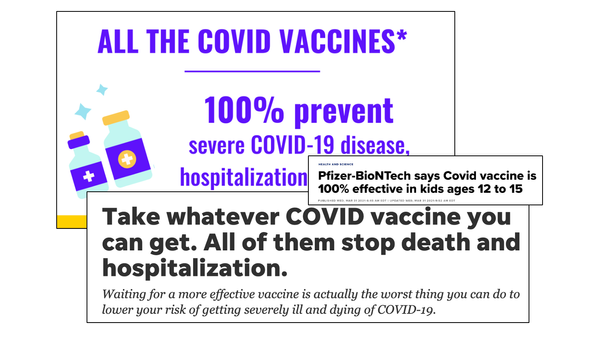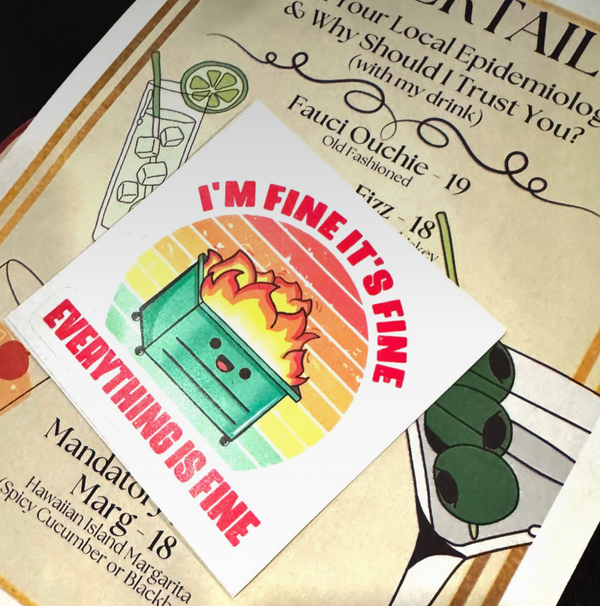Pandemic contradictions: a sign of false information

One of the reasons false information and pandemic rumors can be so confusing and exhausting is the high degree of self-contradiction. Granted, not everyone believes every rumor simultaneously, but overall self-contradiction is often a hallmark of inaccurate information, and exposure to many different self-contradicting narratives (often with lots of emotion attached to them) can be highly disorienting and confusing. Here are a few examples I’ve run into over the last year:
“Spike protein shedding from vaccination makes it dangerous to be around vaccinated people” and “spike protein shedding from COVID infection is no big deal and there’s no need to social distance or wear a mask.”
“SARS-CoV-2 is not that dangerous” and “SARS-COV-2 is so good at making humans sick that it was clearly engineered.”
“A ~1% death rate from COVID is not a big deal” and “an extremely rare (<0.001%) nonfatal side effect from a vaccine is a very big deal.”
“If a 75-year-old with pre-existing conditions gets COVID and dies from pneumonia 4 days later, COVID was not the true cause” and “if a 75-year-old with pre-existing conditions gets the vaccine and dies from pneumonia 4 days later, the vaccine was definitely the true cause.”
“Most COVID cases are false positives” and “the case fatality rate is overestimated.” (If there were, in fact, fewer true COVID cases due to false positives, that would make the case fatality rate much higher.)
“Saying that ‘COVID is dangerous’ is fear-mongering” and “saying that ‘there is a massive network of elites who are secretly conspiring to take over the world by introducing a genetically engineered virus and forced vaccination with microchips’ is not fear-mongering.”
“The SARS-CoV-2 spike protein is dangerous” and “SARS-CoV-2 is not dangerous.”
“Foreign, non-replicating RNA from the vaccine inside human cells is dangerous” and “foreign, self-replicating RNA from the virus inside human cells is not a big deal.”
“Immune systems are naturally strong; they can handle the virus without help from the vaccine” and “immune systems can’t handle masks.”
“An observational study of ~30 people is enough to justify giving hydroxychloroquine for COVID” and “A randomized, blinded placebo-controlled trial of ~30,000 people is not large enough to justify giving the vaccine.”
“COVID isn’t real” and “COVID is a bioweapon.”
“mRNA vaccines are extremely new technology.” “Dr. Robert Malone is the inventor of the mRNA vaccines as evidenced by the study he published in 1989.”
“Ivermectin reduces the risk of death from COVID, this drug is a game changer!”
“COVID vaccines reduce the risk of death from COVID, but because some people still die, they don’t really work.”
“COVID cases counts aren’t reliable at all” and “rising COVID cases show vaccines don’t work.”
If you’ve felt like your brain has been in a fog trying to sort through all the COVID information out there, this may be part of the reason why. Self-contradicting narratives can create a swirl of confusion that makes it hard to know what is what. Hopefully seeing some of these contradictions clearly laid out makes it easier to see how these rumors don’t hold up.
If you’d like more information on some of the statements above, here are some explanations that go into the detail of the science behind them:
- How COVID deaths are counted
- What VAERS vaccine death reports mean
- How we know vaccination doesn’t cause spike protein shedding
- An overview of mRNA vaccine safety data
- An assessment of hydroxychloroquine as ‘the key to defeating COVID’
- How we know the mRNA vaccines work
- Addressing rumors that masks are dangerous and ineffective
- How we know the mRNA vaccines won’t change your DNA
- Addressing the rumor that the COVID vaccines cause infertility
- Why COVID is different than the flu
- What are unfalsifiable hypothesis, and why they can trap people
- 10 common mRNA vaccine rumors addressed
- Addressing the idea that masks hurt the immune system
- If the spike protein is harmful during COVID infection, why isn’t it harmful in the vaccine?




